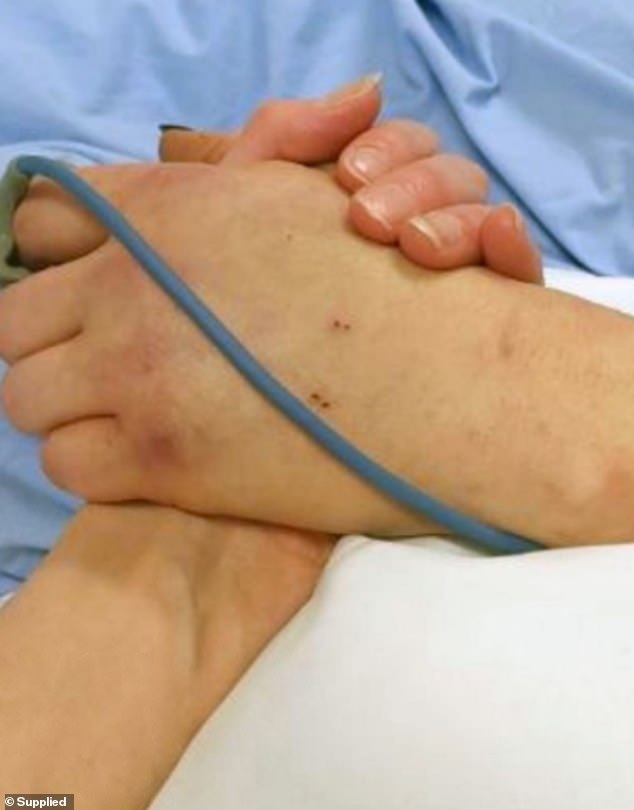
A mum-of-two almost died after developing a deadly flesh-eating disease following a fall at work.
Hospitality worker Amanda Stacey slipped and fell in the kitchen of an RSL club in Melbourne last September, leaving her with a small cut on her right forearm.
The mum, from Burnside, covered the cut with an band-aid and continued working, more concerned over her bruised right arm.
But she ended up being rushed to hospital after developing necrotising fasciitis – a rare bacterial infection – where she ended up in a coma for 10 days before waking up with a tube down her throat.

Former hospitality worker Amanda Stacey (pictured, with her 11-year-old daughter) slipped and fell while on duty at a Melbourne RSL kitchen when she cut her forearm




The mum of two (pictured, with family wearing a stocking on her arm that covers the wound) was rushed to hospital after developing Necrotising fasciitis






‘I couldn’t talk, see properly, or walk. I had to have surgery to have the flesh removed. I was in hospital for weeks,’ Ms Stacey said
‘I was doing some cleaning at the time and I just slipped,’ Ms Stacey told Nine News.
‘I hit my arms on the bench on the way down and my bottom on the floor.’
It was not until less than two days later the mother of two started to ‘feel a bit off’ while working another shift.
She was sent home sick and said she sent texts to her friends telling them she was ‘laid up and sore everywhere’.
‘When I began to feel unwell, the infection had already taken hold and it wasn’t something I could sleep off,’ Ms Stacey said.
Her 14-year-old daughter who was staying at her father’s place for the weekend with her sister grew concerned after she made several calls to her mum which were not answered.
She then called on a friend of her mother’s to go check on her and when the woman arrived she found Ms Stacey unconscious with a very swollen arm.
The friend then called an ambulance before Ms Stacey was rushed to Footscray Hospital where she spent 10 days in a coma and came close to becoming septic.
‘If she hadn’t done that I might not be here today. Hospital staff were telling my parents I might not make it,’ Ms Stacey said.
She had developed necrotising fasciitis where doctors explained her entire body was in danger of being poisoned.
‘The blood infection was fast moving and affected the whole right side of my body. I woke up with a big tube down my throat. It was such a shock,’ she said.
‘I couldn’t talk, see properly, or walk. I had to have surgery to have the flesh removed. I was in hospital for weeks after that.’
When Ms Stacey was discharged she had to take time away from her job to recover from the horrific injury which still remains open at the elbow.
‘When I was allowed to go home, I was really struggling financially not being able to work so I had to get legal support. I was hesitant at first,’ the mother said.
She didn’t apply for workers compensation at the time as she preferred to not financially burden her boss.
But she realised she I had to do something as she ran out of savings ‘otherwise my kids were going to be the ones that suffered’.
Law firm Slater and Gordon took her case on and made a claim through the government’s WorkCover compensation scheme on behalf of the injured mum.
‘When you can’t work and earn an income, it makes things very stressful. The stress and pressure can sometimes be worse than managing the injury itself,’ Ms Stacey said.
But her claim was successful and she now gets a large portion of her wages through Workcover as she continues her recovery.
Ms Stacey still has significant scarring left over from the injury so she wears a stocking over it.
Slater and Gordon lawyer Michelle Cavalieri said workers can get compensation if they’ve injured themselves while on the job even if its not the fault of the employer.
Ms Cavalieri said it doesn’t matter how one gets an injury as people can claim even if they trip over their own shoelaces at work.
The workers compensation lawyer said if it occurred at work or during those hours you are entitled to get support.
‘Workplaces are insured for this reason and pay premiums to a WorkCover insurer, to ensure a worker is covered financially in case of injury,’ she said.
She said some workplaces will tell employees not to lodge a WorkCover claim and that they will fund their medical costs.
‘But this is doing the worker a great disservice, because they miss out on lost wages and any future economic loss that might occur,’ Ms Cavalieri said.
Meanwhile, Ms Stacey encouraged others in her situation to get help if they are injured at work.
‘I never thought this could have happened to me but it did,’ she said.
Source: | This article originally belongs to Dailymail.co.uk